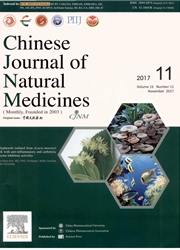

 中文摘要:
中文摘要:
Anticancer targets of cryptotanshinone were evaluated and rapidly forecasted with PharmMapper, a reverse pharmacophore-based screening platform, as well as drug target databases, including PDTD, DrugBank and TTD. The pathway analyses for the collection of anticancer targets screened were carried out based on the KEGG pathway database, followed by the forecast of potential pharmacological activities and pathways of the effects of cryptotanshinone, and verification of some of the targets screened using whole cell tests. The results showed that a total of eight targets with anticancer potential were screened, including MAP2K1, RARα, RXRα, PDK1, CHK1, AR, Ang-1 R, and Kif11. These targets are mainly related to four aspects of the cancer growth: the cell cycle, angiogenesis, apoptosis, and androgen receptor. The cell tests showed that cryptotanshinone can inhibit the viability of human hepatoma cells SMMC-7721, which is related to the reduction of expression of MAP2K1 mRNA. This method provides a strong clue for the study of the anticancer effects and mechanisms of action of cryptotanshinone in the future.
 英文摘要:
英文摘要:
Anticancer targets of cryptotanshinone were evaluated and rapidly forecasted with PharmMapper, a reverse pharmacophore-based screening platform, as well as drug target databases, including PDTD, DrugBank and TTD. The pathway analyses for the collection of anticancer targets screened were carried out based on the KEGG pathway database, followed by the forecast of potential pharmacological activities and pathways of the effects of cryptotanshinone, and verification of some of the targets screened using whole cell tests. The results showed that a total of eight targets with anticancer potential were screened, including MAP2K1, RARα, RXRα, PDK1, CHK1, AR, Ang-1 R, and Kifll. These targets are mainly related to four aspects of the cancer growth: the cell cycle, angiogenesis, apoptosis, and androgen receptor. The cell tests showed that cryptotanshinone can inhibit the viability of human hepatoma cells SMMC-7721, which is related to the reduction of expression of MAP2K1 mRNA. This method provides a strong clue for the study of the anticancer effects and mechanisms of action of cryptotanshinone in the future.
 同期刊论文项目
同期刊论文项目
 同项目期刊论文
同项目期刊论文
 Bioactive tanshinones in Salvia miltiorrhiza inhibit the growth of prostate cancer cells in vitro an
Bioactive tanshinones in Salvia miltiorrhiza inhibit the growth of prostate cancer cells in vitro an Cryptotanshinone has diverse effects on cell cycle events in melanoma cell lines with different meta
Cryptotanshinone has diverse effects on cell cycle events in melanoma cell lines with different meta Xanthatin induces cell cycle arrest at G2/M checkpoint and apoptosis via disrupting NF-κB pathway in
Xanthatin induces cell cycle arrest at G2/M checkpoint and apoptosis via disrupting NF-κB pathway in Comparative Effects of Hirudo, Frankincense, and Motherwort on Inhibition of Blood Platelet Aggregat
Comparative Effects of Hirudo, Frankincense, and Motherwort on Inhibition of Blood Platelet Aggregat Luteolin reduces the invasive potential of malignant melanoma cells by targeting β3 integrin and the
Luteolin reduces the invasive potential of malignant melanoma cells by targeting β3 integrin and the Inhibition of hypoxia-induced epithelial mesenchymal transition by luteolin in non-small cell lung c
Inhibition of hypoxia-induced epithelial mesenchymal transition by luteolin in non-small cell lung c Effect of Aqueous Extracts of Several Kinds of Herbs on Human Platelet Aggregation and Expression of
Effect of Aqueous Extracts of Several Kinds of Herbs on Human Platelet Aggregation and Expression of Chemomodulatory effi cacy of lycopene on antioxidant enzymes and carcinogen-induced cutaneum carcino
Chemomodulatory effi cacy of lycopene on antioxidant enzymes and carcinogen-induced cutaneum carcino Holothurian glycosaminoglycan inhibits metastasis and thrombosis via targeting of nuclear factor-kap
Holothurian glycosaminoglycan inhibits metastasis and thrombosis via targeting of nuclear factor-kap Inhibition of vascular endothelial growth factor-mediated angiogenesis involved in reproductive toxi
Inhibition of vascular endothelial growth factor-mediated angiogenesis involved in reproductive toxi Holothurian Glycosaminoglycan Inhibits Metastasis and Thrombosis viaTargeting of Nuclear Factor-κB/T
Holothurian Glycosaminoglycan Inhibits Metastasis and Thrombosis viaTargeting of Nuclear Factor-κB/T Concerted Suppressionof STAT3 and GSK3β Is Involved in Growth Inhibition of Non-Small Cell LungCance
Concerted Suppressionof STAT3 and GSK3β Is Involved in Growth Inhibition of Non-Small Cell LungCance CryptotanshinoneActivates p38/JNK and Inhibits Erk1/2 Leading to Caspase-Independent Cell Deathin Tu
CryptotanshinoneActivates p38/JNK and Inhibits Erk1/2 Leading to Caspase-Independent Cell Deathin Tu Luteolin reduces theinvasive potential of malignant melanoma cells by targeting β3 integrin and thee
Luteolin reduces theinvasive potential of malignant melanoma cells by targeting β3 integrin and thee Inhibition of hypoxia-induced epithelialmesenchymal transition by luteolin in non-small cell lung ca
Inhibition of hypoxia-induced epithelialmesenchymal transition by luteolin in non-small cell lung ca The Angiogenic Responses Induced by Release of AngiogenicProteins from Tumor Cell-Activated Platelet
The Angiogenic Responses Induced by Release of AngiogenicProteins from Tumor Cell-Activated Platelet Cryptotanshinone, a novel tumor angiogenesisinhibitor, destabilizes tumor necrosis factor-a mRNA via
Cryptotanshinone, a novel tumor angiogenesisinhibitor, destabilizes tumor necrosis factor-a mRNA via Chemopreventive efficacy of menthol on carcinogen-induced cutaneous carcinoma in mice throughinhibit
Chemopreventive efficacy of menthol on carcinogen-induced cutaneous carcinoma in mice throughinhibit Cancer-promotingeffect of capsaicin on DMBA/TPA-induced skin tumorigenesis by modulatinginflammation
Cancer-promotingeffect of capsaicin on DMBA/TPA-induced skin tumorigenesis by modulatinginflammation Holothurian glycosaminoglycan inhibits metastasis via inhibition of P-selectin in B16F10 melanoma ce
Holothurian glycosaminoglycan inhibits metastasis via inhibition of P-selectin in B16F10 melanoma ce PKM2 Regulates Hepatocellular Carcinoma Cell Epithelial-mesenchymal Transition and Migration upon EG
PKM2 Regulates Hepatocellular Carcinoma Cell Epithelial-mesenchymal Transition and Migration upon EG PKM2 Regulates Hepatocellular Carcinoma Cell Epithelialmesenchymal Transition and Migration upon EGF
PKM2 Regulates Hepatocellular Carcinoma Cell Epithelialmesenchymal Transition and Migration upon EGF Phenolcarboxylic acids from medicinal herbs exert anticancer effects through disruption of COX-2 act
Phenolcarboxylic acids from medicinal herbs exert anticancer effects through disruption of COX-2 act 期刊信息
期刊信息
